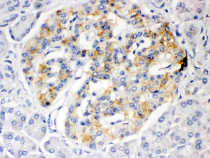ARG40283
anti-ISG15 antibody
anti-ISG15 antibody for IHC-Formalin-fixed paraffin-embedded sections,Western blot and Human
Overview
| Product Description | Rabbit Polyclonal antibody recognizes ISG15 |
|---|---|
| Tested Reactivity | Hu |
| Tested Application | IHC-P, WB |
| Host | Rabbit |
| Clonality | Polyclonal |
| Isotype | IgG |
| Target Name | ISG15 |
| Antigen Species | Human |
| Immunogen | Recombinant protein corresponding to G2-G157 of Human ISG15. |
| Conjugation | Un-conjugated |
| Alternate Names | G1P2; IP17; UCRP; Interferon-induced 15 kDa protein; Interferon-induced 17 kDa protein; hUCRP; IFI15; Ubiquitin cross-reactive protein; Ubiquitin-like protein ISG15; IMD38 |
Application Instructions
| Application Suggestion |
|
||||||
|---|---|---|---|---|---|---|---|
| Application Note | IHC-P: Antigen Retrieval: By heat mediation. * The dilutions indicate recommended starting dilutions and the optimal dilutions or concentrations should be determined by the scientist. |
||||||
| Observed Size | ~ 15 kDa |
Properties
| Form | Liquid |
|---|---|
| Purification | Affinity purification with immunogen. |
| Buffer | 0.2% Na2HPO4, 0.9% NaCl, 0.05% Sodium azide and 5% BSA. |
| Preservative | 0.05% Sodium azide |
| Stabilizer | 5% BSA |
| Concentration | 0.5 mg/ml |
| Storage Instruction | For continuous use, store undiluted antibody at 2-8°C for up to a week. For long-term storage, aliquot and store at -20°C or below. Storage in frost free freezers is not recommended. Avoid repeated freeze/thaw cycles. Suggest spin the vial prior to opening. The antibody solution should be gently mixed before use. |
| Note | For laboratory research only, not for drug, diagnostic or other use. |
Bioinformation
| Database Links | |
|---|---|
| Gene Symbol | ISG15 |
| Gene Full Name | ISG15 ubiquitin-like modifier |
| Background | The protein encoded by this gene is a ubiquitin-like protein that is conjugated to intracellular target proteins upon activation by interferon-alpha and interferon-beta. Several functions have been ascribed to the encoded protein, including chemotactic activity towards neutrophils, direction of ligated target proteins to intermediate filaments, cell-to-cell signaling, and antiviral activity during viral infections. While conjugates of this protein have been found to be noncovalently attached to intermediate filaments, this protein is sometimes secreted. [provided by RefSeq, Dec 2012] |
| Function | Ubiquitin-like protein which plays a key role in the innate immune response to viral infection either via its conjugation to a target protein (ISGylation) or via its action as a free or unconjugated protein. ISGylation involves a cascade of enzymatic reactions involving E1, E2, and E3 enzymes which catalyze the conjugation of ISG15 to a lysine residue in the target protein. Its target proteins include IFIT1, MX1/MxA, PPM1B, UBE2L6, UBA7, CHMP5, CHMP2A, CHMP4B and CHMP6. Can also isgylate: EIF2AK2/PKR which results in its activation, DDX58/RIG-I which inhibits its function in antiviral signaling response, EIF4E2 which enhances its cap structure-binding activity and translation-inhibition activity, UBE2N and UBE2E1 which negatively regulates their activity, IRF3 which inhibits its ubiquitination and degradation and FLNB which prevents its ability to interact with the upstream activators of the JNK cascade therby inhibiting IFNA-induced JNK signaling. Exhibits antiviral activity towards both DNA and RNA viruses, including influenza A, HIV-1 and Ebola virus. Restricts HIV-1 and ebola virus via disruption of viral budding. Inhibits the ubiquitination of HIV-1 Gag and host TSG101 and disrupts their interaction, thereby preventing assembly and release of virions from infected cells. Inhibits Ebola virus budding mediated by the VP40 protein by disrupting ubiquitin ligase activity of NEDD4 and its ability to ubiquitinate VP40. ISGylates influenza A virus NS1 protein which causes a loss of function of the protein and the inhibition of virus replication. The secreted form of ISG15 can: induce natural killer cell proliferation, act as a chemotactic factor for neutrophils and act as a IFN-gamma-inducing cytokine playing an essential role in antimycobacterial immunity. [UniProt] |
| Cellular Localization | Cytoplasm. Secreted. Note=Exists in three distinct states: free within the cell, released into the extracellular space, or conjugated to target proteins. [UniProt] |
| Calculated MW | 18 kDa |
| PTM | S-nitrosylation decreases its dimerization, thereby increasing the availability as well as the solubility of monomeric ISG15 for its conjugation to cellular proteins. Induced as an inactive, precursor protein that is cleaved by specific proteases to expose the C-terminal diglycine (LRLRGG) motif. This motif is essential not only for its conjugation to substrates but also for its recognition by the relevant processing proteases. [UniProt] |
Images (2) Click the Picture to Zoom In
-
ARG40283 anti-ISG15 antibody IHC-P image
Immunohistochemistry: Paraffin-embedded Human pancreatic cancer tissue stained with ARG40283 anti-ISG15 antibody at 1 µg/ml dilution.
-
ARG40283 anti-ISG15 antibody WB image
Western blot: 22Rv1 and HeLa whole cell lysates stained with ARG40283 anti-ISG15 antibody at 0.5 µg/ml dilution.







